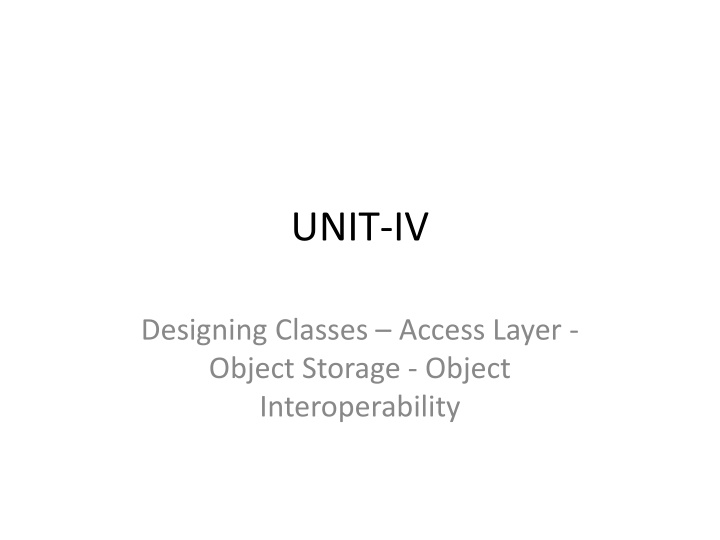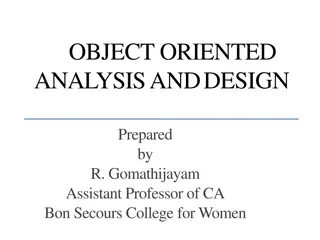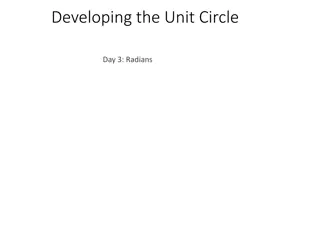
Object-Oriented Design: Classes, Protocols, and Visibility
Learn about designing classes, protocols, and class visibility in object-oriented design, including UML Object Constraint Language (OCL) syntax, refining attributes and methods, and the importance of well-defined public, private, and protected protocols.
Download Presentation

Please find below an Image/Link to download the presentation.
The content on the website is provided AS IS for your information and personal use only. It may not be sold, licensed, or shared on other websites without obtaining consent from the author. If you encounter any issues during the download, it is possible that the publisher has removed the file from their server.
You are allowed to download the files provided on this website for personal or commercial use, subject to the condition that they are used lawfully. All files are the property of their respective owners.
The content on the website is provided AS IS for your information and personal use only. It may not be sold, licensed, or shared on other websites without obtaining consent from the author.
E N D
Presentation Transcript
UNIT-IV Designing Classes Access Layer Object Storage Object Interoperability
Objectives Students should be able to define and understand Designing Classes Designing Protocols and Class Visibility The UML Object Constraint Language (OCL) Designing Methods
The Object-Oriented Design Philosophy Important activity in building an application, should be to design a set of classes, each of which has a specific expertise and all of which can work together in useful ways.
UML Object Constraint Language UML is a graphical language with a set of rules and semantics. The rules and semantics are expressed in English, in a form known Object Constraint Language (OCL). OCL Is a specification language. Uses simple logic for specifying the properties of a system. UML modeling constructs require expressions. (eg., type, Boolean values, numbers). Expressions are stated as strings in OCL.
UML Object Constraint Language Syntax for some common navigational expressions Item.selector : The selector is the name of an attribute in the item. (eg., Jhon.age) Item.selector[qualifier-value] : The selector indicates a qualified association that qualifies the item. The result is the related object selected by the qualifier. (eg.,John.Phone[2]) Set -> select (Boolean-expression) : The Boolean expression is written in terms of objects within the set. The result is the subset of objects in the set for which the Boolean expression is true. (eg., company.employee -> salary>30000)
Designing Classes Designing Business Layer classes 1.1 Apply design axioms to design classes, their attributes, methods, associations, structures, and protocols. 1.2 Refine and complete the UML Class Diagram by adding details. This step consists of Refine attributes, methods, cardinality, visibility, association and class hierarchy. 1.2.1 Refine attributes 1.2.2 Design methods and protocols by utilizing a UML activity diagrams to represent the method s algorithm. 1.2.3 Refine associations between classes (if required). 1.2.4 Refine class hierarchy and design with inheritance (if required). 1.3 Iterate and refine again.
Class Visibility: Designing Well-Defined Public, Private, and Protected Protocols Public Protocol Layer: External Items in this layer define the functionality of the object. Things to keep in mind when designing class protocols Good design allows for polymorphism. Not all protocol should be public.
Designing Classes: Refining Attributes Attributes identified in OOA must be refined with respect to implementation during OOD. In Analysis Phase Attribute Name is sufficient. In Design Phase detailed information must be added to the class (defining attributes,operations). Goal Refine existing attributes (identified in analysis) or add attributes that can elevate the system into implementation.
Attribute Types Single-value attributes Multiplicity or multivalue attributes Reference to another object, or instance connection
UML Attribute Presentation OCL can be used to define the class attributes. Syntax visibility name : type-expression = initial-value where, Visibility is one of the following + public visibility # protected visibility - private visibility Type-expression is a language-dependent specification of the implementation type of an attribute. Initial-value is a language-dependent expression for the initial value of a newly created object. (optional) Multiplicity indicator (array) can be represented as Eg., Names[10]: String points[2..*] : Point
Designing Classes: Refining Attributes ATM Example
Designing Methods and Protocols Goal Is to specify the algorithm for methods identified. Once methods are designed in some formal structure such as UML activity diagrams with an OCL description, they can be converted to programming languages manually or automated (i.e., using CASE Tools).
Types of methods Constructor Destructor Conversion method Copy method Attribute set Attribute get I/O methods Domain specific methods
Highly cohesive objects can improve coupling because only a minimal amount of information need to be passed between objects. Abstraction leads to simplicity and also increases class versatility. The requirement of simplification, while retaining the functionality, seems to lead to increased utility.
Rules If it looks messy, then it's probably a bad design. If it is too complex, then it's probably a bad design. If it is too big, then it's probably a bad design. If people don't like it, then it's probably a bad design. If it doesn't work, then it's probably a bad design
Design Issues : Avoiding Design Pitfalls Keep a careful eye on the class design and make sure that an object s role remains well defined. If an object loses focus, you need to modify the design. Apply Corollary 2 (Single purpose). Move some functions into new classes that the object would use. Apply Corollary 1 (Uncoupled design with less information content). Break up the class into two or more classes. Apply Corollary 3 (Large number of simple classes). Rethink the class definition based on experience gained.
methods UML Operation Presentation OCL can be used to define the class attributes. Syntax visibility name : (parameter-list) : return-type-expression where, Visibility is one of the following + public visibility # protected visibility - private visibility Parameter-list is a list of parameters, separated by commas, each specified by name : type-expression = default value Return-type-expression is a language-dependent specification of the implementation of the value returned by the method. If return-type is omitted, the operation does not return a value.
Packages and Managing Classes A package groups and manages the modeling elements, such as classes, their associations, and their structures. package may contain both other packages and ordinary modeling elements.






















